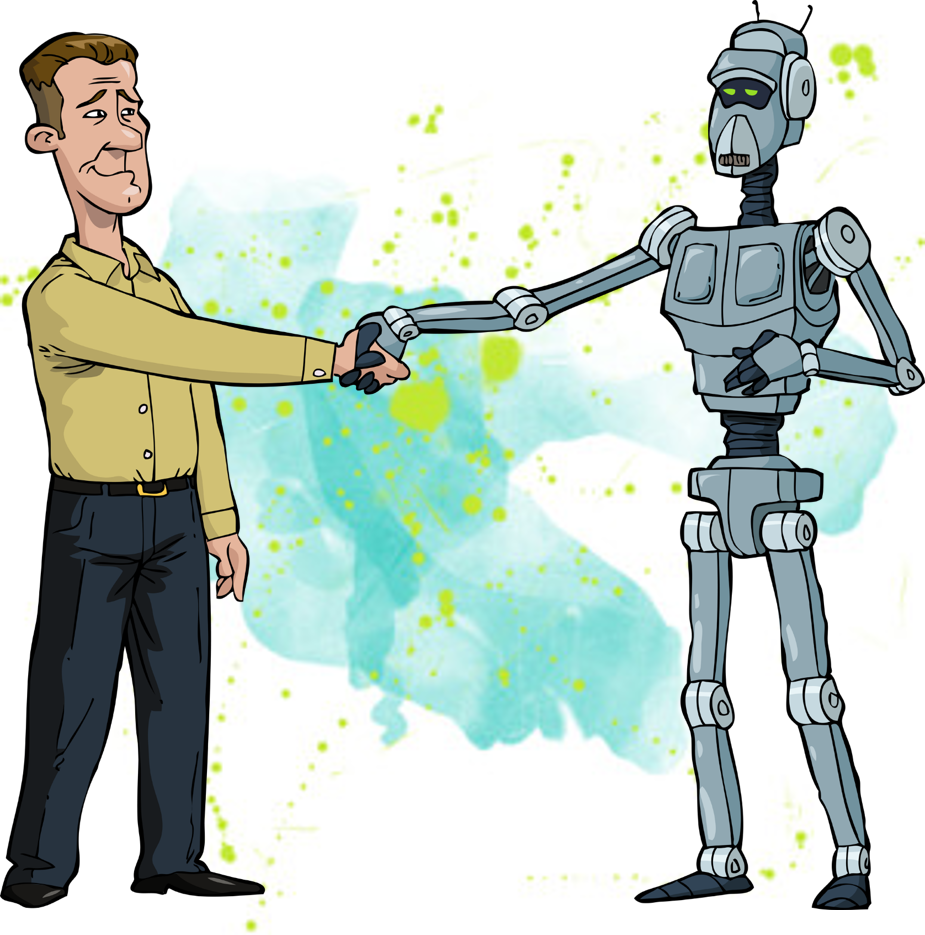Pundits seem a lot more worried about job losses attributed to artificial intelligence (AI) and robotics than the workers who could be replaced. “For years now,” writes Wanda Thibodeaux (@WandaThibodeaux), “professionals have voiced concerns that robots and automation would steal jobs away from hardworking individuals. The bulk of workers, though, are actually pretty laid back about the idea of robots in the workforce and aren’t concerned that their jobs are at stake.”[1] She draws that conclusion from a survey conducted by Kryon which found “over 70 percent of individuals are not concerned that robots will be capable of replacing them in the workplace. Some of this confidence comes from the fact that people still perceive the human mind as superior, with 75 percent of respondents saying they’re not worried that the robots have more potential or intellectual capability than themselves.” Undoubtedly, some pundits will insist workers are in a deep state of denial. The truth probably lies somewhere between AI and robotics having some impact and enormous negative impact on jobs sustainability.
Humans and Smart Machines
Business leaders are always looking for the most affordable way to increase productivity. Automation has historically been one path to that goal. Many pundits believe full automation and massive unemployment are what lie at the end of that path. I tend to agree with subject matter experts who assert business leaders will eventually adopt a work environment in which humans and machines work side-by-side as co-workers. This prediction is based on the fact that humans and machines have different strengths which are not easily achievable by either machines or humans alone. Nevertheless, this vision of the future should not foster complacency in the workforce. Jason Thacker (@jasonthacker) explains, “While a complete AI takeover of the workforce is not likely imminent or even possible at this point, many of the jobs that are currently available might not exist in the near future, or will look very different.”[2] Workers who are confident their jobs are safe and do nothing to plan for the future will likely find themselves in the unemployment office looking for work. Former IBM executive Irving Wladawsky-Berger observes, “Artificial intelligence feels different from previous technologies as it forces us to explore the very boundaries between machines and humans. Will AI lead to whole new jobs and industries and a higher standard of living? Or are we facing a dystopian future, as smart machines increasingly encroach on activities and cognitive capabilities that not long ago were viewed as the exclusive domain of humans?”[3]
Deloitte analysts believe AI and robotics have the potential to improve the work environment for some humans. They explain, “Robotics, cognitive, artificial intelligence, and other ‘smart’ solutions are increasingly providing the means to automate certain low-level workplace tasks. This could empower human workers to focus on aspects of their jobs that require strategic thinking, social savvy, or emotional intelligence, among other skills.”[4] Regardless of whether a job is changed or eliminated, to remain relevant workers must evolve. Unfortunately, the Council on Foreign Relations asserts little effort is being made towards keeping the workforce relevant. A report issued by the Council concludes, “The workforce is being transformed via smart machines and other technologies but the U.S. isn’t preparing workers for these changes.”[5]
The Future Workforce
The Council on Foreign Relations’ report concludes all stakeholders need to be involved in preparing the workforce for tomorrow’s work environment. It states, “Governments, businesses, educators, and other institutions need to do far more to help Americans adapt and thrive in the face of these disruptive forces.” Workers themselves have the most to lose if they don’t also play an important role in preparing for the future. A survey released by Intel discusses how cooperation between companies and workers can help usher in the workplace of the future characterized by human/machine collaboration. The report concludes, “If companies today focus their efforts on addressing labor pain points, engaging their workers in the change process and bridging an understanding, skills and trust gap, the intelligent factory may be fewer than five years away.”[6] Irene Petrick, director of industrial innovation at Intel’s Internet of Things Group, explains the transformation process won’t be easy. “It is likely that there will be unbalanced progress (between the workforce and technology) at any point in time,” Petrick states. “This will happen, in part, because workers may not be able to express exactly what they need or want, or because technology is moving faster than the process into which it must be situated.”
Darrell M. West (@darrwest), Vice President and Director of Governance Studies at the Brookings Institution, predicts the speed at which technologies will be introduced will also be faster than government regulators can act. He explains, “With some workforce disruption virtually guaranteed by trends already underway, it is safe to predict American politics will be chaotic and turbulent during the coming decades. As innovation accelerates and public anxiety intensifies, right-wing and left-wing populists will jockey for voter support. Government control could gyrate between very conservative and very liberal leaders as each side blames a different set of scapegoats for economic outcomes voters don’t like.”[7] The Council on Foreign Relations recommends seven steps that can be taken to prepare today’s workers for tomorrow’s workplace. They are:
1. Help Americans take advantage of the opportunities posed by technology. “Many of the new jobs being created will require significantly higher levels of education and skills.”
2. Strengthen the link between education and employment. “The challenge is not just providing more education but providing better-targeted education that leads to better work opportunities.”
3. Spur job creation, especially for better-paying jobs. “Employers should commit themselves to creating a ‘high-road workplace’ that offers employees decent pay, training, scheduling, and benefits.”
4. Make the skill demands of jobs more transparent. “Improvements in credential quality and transparency will also feed back into the educational choices of young people, helping companies to develop the talent pipelines they need.”
5. Provide better help for displaced workers. “The United States spends just 0.1% of gross domestic product, roughly one-fifth of what the average European country spends, on training and assistance for those who have lost jobs. The United States needs to emulate the best models for helping displaced workers.”
6. Improve the benefits and returns from work for all Americans. “The United States should create portable systems of employment benefits tied to individual employees rather than to the jobs themselves.”
7. Understand that the problems will not be solved by Washington alone. “To underscore the urgency of the task of building the workforce of the future, the president and the nation’s governors should create a National Commission on the U.S. Workforce to carry out research, share best practices, and conduct public outreach on workforce challenges.”
Summary
In their book Human + Machine: Reimagining Work in the Age of AI, Accenture executives Paul Daugherty and Jim Wilson, write, “The simple truth is that machines are not taking over the world, nor are they obviating the need for humans in the workplace. In this current era of business process transformation, AI systems are not wholesale replacing us; rather, they are amplifying our skills and collaborating with us to achieve productivity gains that have previously not been possible.” Deloitte analysts agree with that conclusion. They write, “Rather than displace human workers, bots and other intelligent automation solutions are providing a foundation for human-machine collaboration. This burgeoning no-collar workforce is helping leaders to envision new modes of work that can reduce costs and free up humans to perform more valuable tasks on behalf of the organization.” Despite such optimistic predictions, some jobs will be lost to AI and robotics. Workers made redundant by automation need to be retrained, reskilled, and reeducated so they can fill jobs that will be available in the new business environment.
Footnotes
[1] Wanda Thibodeaux, “Why 70 Percent of Workers Aren’t Scared of Robots Taking Their Jobs,” Inc., April 2018.
[2] Jason Thacker, “The future is here: Artificial Intelligence and the changing workforce,” The Ethics & Religious Liberty Commission of the Southern Baptist Convention, 23 April 2018.
[3] Irving Wladawsky-Berger, “Human + Machine: The Impact of AI on Business Transformation,” The Wall Street Journal, 13 April 2018.
[4] Deloitte, “Workers and Bots, Unite!” The Wall Street Journal, 16 April 2018.
[5] Staff, “US Needs to do Better Job Preparing Workforce for Technological Advances,” IndustryWeek, 24 April 2018.
[6] Edwin Lopez, “Smart factories will require a ‘coevolution’ of workers and operations,” Supply Chain Dive, 24 April 2018.
[7] Darrell M. West, “Will robots and AI take your job? The economic and political consequences of automation,” The Brookings Institution, 18 April 2018.





